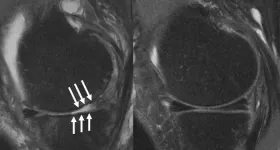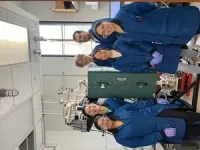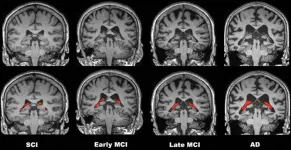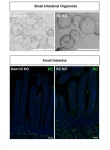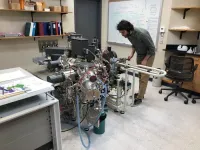(Press-News.org) CHICAGO – Stronger quadriceps muscles, relative to the hamstrings, may lower the risk of total knee replacement, according to research being presented today at the annual meeting of the Radiological Society of North America (RSNA). Researchers said the findings could inform strength-training programs for people with advanced arthritis in the knee.
Advanced knee osteoarthritis is a major cause of pain and disability worldwide. In the U.S. alone, 14 million adults have symptomatic knee osteoarthritis, and more than half of those diagnosed are projected to eventually undergo total knee replacement surgery.
While stronger muscle groups are generally understood to be associated with a lower rate of total knee replacement, their relative importance is not well established. Of particular interest is the relationship between the extensors and the hamstrings, the two most important muscle groups in the knee.
The extensors, the muscles on the front of the thigh commonly referred to as the quadriceps, are the strongest muscle group in the body and have essential influence on gait, other activities and biomechanics. The muscles around the back of the thigh known as the hamstrings are responsible for extension of the hip and flexion of the knee, making them equally essential for physical activity.
“The two muscle groups act as counter forces, and the balance between them enables a wide range of activities while protecting the knee joint,” said study lead author Upasana Upadhyay Bharadwaj, M.D., from the University of California, San Francisco (UCSF). “An imbalance, in addition to other factors, leads to a change in the biomechanics resulting in the progression of osteoarthritis.”
Dr. Upadhyay Bharadwaj and colleagues evaluated thigh muscle volume in 134 participants from the Osteoarthritis Initiative, a nationwide study sponsored by the National Institutes of Health. They compared 67 patients who underwent total knee replacement of a single knee with 67 control participants who had not undergone knee replacement. The cases and controls were matched for variables including age and gender.
The researchers obtained 3T MRI of the thigh at the time of surgery. They also evaluated MRI findings from two years and four years before the surgery. They used a previously trained deep-learning model to segment and compute volumes of the muscles of the thigh—measures that are tedious to compute manually.
Comparing patients who had total knee replacement with the control group, a higher ratio of quadriceps to hamstring volume was significantly associated with lower odds of total knee replacement. Higher volumes of hamstrings and gracilis, a long, thin muscle on the inside of the thigh, were also linked with lower odds of total knee replacement.
“Our study shows that in addition to strong muscles individually, larger extensor muscle groups—relative to hamstring muscle groups—are significantly associated with lower odds of total knee replacement surgery in two to four years,” Dr. Upadhyay Bharadwaj said.
The study findings have implications for both the interpretation of imaging exams and clinical management. The results suggest that training programs that strengthen the quadriceps in relation to the hamstrings may be beneficial.
“Although we presume that overall muscle volume is important as a surrogate marker for muscle strength, the ratio, hence the balance, between extensor and hamstring muscles may be more important and significantly associated with lower odds of total knee replacement,” Dr. Upadhyay Bharadwaj said.
Although the study focused on people with arthritis, the findings may also help inform strength training for a wider segment of the population.
“While these results are essential for targeted therapy in a population at risk for osteoarthritis, even the general public can benefit from our results to preventively incorporate appropriate strengthening exercises,” Dr. Upadhyay Bharadwaj said.
Co-authors are John A. Lynch, Ph.D., Gabby B. Joseph, Ph.D., and Thomas M. Link, M.D., Ph.D.
###
Note: Copies of RSNA 2023 news releases and electronic images will be available online at RSNA.org/press23.
RSNA is an association of radiologists, radiation oncologists, medical physicists and related scientists promoting excellence in patient care and health care delivery through education, research and technologic innovation. The Society is based in Oak Brook, Illinois. (RSNA.org)
Editor’s note: The data in these releases may differ from those in the published abstract and those actually presented at the meeting, as researchers continue to update their data right up until the meeting. To ensure you are using the most up-to-date information, please call the RSNA Newsroom at 1-312-791-6610.
For patient-friendly information on musculoskeletal imaging, visit RadiologyInfo.org.
END
CHICAGO – Black patients underwent medical imaging for cognitive impairment years later than white and Hispanic patients and were less frequently tested with MRI, according to research being presented this week at the annual meeting of the Radiological Society of North America (RSNA).
Previous studies have shown that Black patients are at increased risk of Alzheimer’s disease and other types of dementia. They are less likely to have a diagnosis and are diagnosed at a more advanced stage of disease compared to white patients.
Medical ...
About 1 in 10 prescription drugs — mainly brand-name and expensive drugs and those for rare diseases — has a manufacturer-sponsored patient support program, which usually includes financial, nursing and educational supports.
"In an era where policy-makers are grappling with escalating drug prices and budgetary impacts globally, the pharmaceutical industry promotes patient support programs as adding complementary value to a drug through supporting medication adherence and enhancing clinical outcomes, patient experience or quality of life," ...
Health Canada increased maximum residue limits for glyphosate in some crops, such as oats and beans, in 2021 despite concerns about the health impact of glyphosate-based herbicides (GBHs). The World Health Organization's (WHO) International Agency for Research on Cancer regards these pesticides as genotoxic, meaning they can damage DNA and are likely carcinogenic.
"Health Canada's PMRA considers pesticide sales and risk evaluation data in Canada to be confidential business information, and independent researchers cannot access these data, even through the Access to Information Act. Such ...
Stem cells can differentiate to replace dead and damaged cells. But how do stem cells decide which type of cell to become in a given situation? Using intestinal organoids, the group of Bon-Kyoung Koo at IMBA and the Institute for Basic Science identified a new gene, Daam1, that plays an essential role, switching on the development of secretory cells in the intestine. This finding, published on November 24 in Science Advances, opens new perspectives in cancer research.
Our bodies are, in some ways, like cars – to keep functioning, they need to be checked and repaired regularly. In the case of our bodies, ...
The Fens of eastern England, a low-lying, extremely flat landscape dominated by agricultural fields, was once a vast woodland filled with huge yew trees, according to new research.
Scientists from the University of Cambridge studied hundreds of tree trunks, dug up by Fenland farmers while ploughing their fields. The team found that most of the ancient wood came from yew trees that populated the area between four and five thousand years ago.
These trees, which are a nuisance when they jam farming equipment during ploughing, contain a treasure trove of perfectly preserved ...
A new study led by UCL researchers confirms that autistic people experience a reduced life expectancy, however the number of years of life lost may not be as high as previously claimed.
The research, published in The Lancet Regional Health – Europe, is the first to estimate the life expectancy and years of life lost by autistic people living in the UK.
The team used anonymised data from GP practices throughout the UK to study people who received an autism diagnosis between 1989 to 2019. They ...
Plants have no visual organs, so how do they know where light comes from? In an original study combining expertise in biology and engineering, the team led by Prof Christian Fankhauser at UNIL, in collaboration with colleagues at EPFL, has uncovered that a light-sensitive plant tissue uses the optical properties of the interface between air and water to generate a light gradient that is 'visible' to the plant. These results have been published in the journal Science.
The majority of living organisms (micro-organisms, plants and animals) have the ability to determine the origin of a light source, even in the absence of a sight organ comparable to the eye. This information is invaluable ...
E. coli bacteria may be far more capable at evolving antibiotic resistance than scientists previously thought, according to a new study published in Science on November 24.
Led by SFI External Professor Andreas Wagner, the researchers experimentally mapped more than 260,000 possible mutations of an E. coli protein that is essential for the bacteria’s survival when exposed to the antibiotic trimethoprim.
Over the course of thousands of highly realistic digital simulations, the researchers then found that 75% of all possible evolutionary paths of the E. coli protein ultimately ...
Blame it on plate tectonics. The deep ocean is never preserved, but instead is lost to time as the seafloor is subducted. Geologists are mostly left with shallower rocks from closer to the shoreline to inform their studies of Earth history.
“We have only a good record of the deep ocean for the last ~180 million years,” said David Fike, the Glassberg/Greensfelder Distinguished University Professor of Earth, Environmental, and Planetary Sciences in Arts & Sciences at Washington University in St. Louis. “Everything else is just shallow-water deposits. So it’s really important to understand the bias that might be present when we look ...
Addressing the long-standing “dolomite problem,” an oddity that has vexed scientists for nearly 200 years, researchers report that dolomite crystals require cycling of saturation conditions to grow. The findings provide new insights into how dolomite is formed and why modern dolomite is primarily found in natural environments with pH or salinity fluctuations. Dolomite – a calcium magnesium carbonate – is one of the major minerals in carbonate rocks, accounting for nearly 30% of the sedimentary carbonate minerality in Earth’s crust. However, despite its geological abundance, dolomite does not readily grow under laboratory conditions, ...
